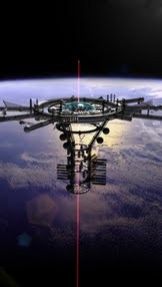20 Years After Nanotube, Space Elevator Project Still Far From Take Off

"The space elevator will be built about 50 years after everyone stops laughing," said the science fiction writer Arthur C. Clarke, long ago.
The quest for Space Elevators dates back to a long past but today the "Space Elevator" becomes a reality.
The Space Elevator is an evolving technology that is expected to replace the chemical rocket technology in future. This new technology will assist access to space and is expected to meet the needs of humanity in terms of clean and renewable energy.
The Space Elevator uses a carbon nanotube as a ribbon for passengers to climb up the orbit of the earth and then launch into distant planets. Despite the successful production in 1991 of carbon nanotubes, making them suitable for a tether still remains a challenge. Once that is achieved, it would help in shipping high-volumes at a lower cost than rockets.
Certainly, Space Elevators are going to be the future transportation system to reach out space. Could the next stop be colonizing Mars?
Essentially, a space elevator is a long cable from Earth's surface into space with its center of mass at geostationary Earth orbit (GEO), 35,786 km in altitude. Electromagnetic vehicles will be traveling along the cable carrying people and payloads between Earth and Space.
In order to fix this cable in place, a base tower approximately 50 km tall has to be tethered to the top with a counterbalance mass beyond geostationary orbit.
Constructing and deploying tether technology in space is a real challenge. Carbon nanotube is the likely material for tethering. It is 180 times stronger than steel cable, with lightweight properties and tensile strength.
"We don't have the ability to make long cable out of the carbon nanotubes at the moment. Although I'm confident that within a reasonable amount of time we will be able to do this," said Professor Jeff Hoffman, Massachusetts Institute of Technology.
According to Smitherman, the construction of a space elevator is not feasible today, but it could be toward the end of the 21st century. "First we'll develop the technology," said Smitherman. "In 50 years or so, we'll be there."
After fixing the right cable in the right place, the next challenge lies with the selection of lightweight, composite structural materials for construction. Then, high-speed, electromagnetic propulsion for mass-transportation systems have to be developed.
Finally, there remains the real challenge of developing transportation, utility and infrastructure to support space construction from Earth out to GEO. The cost of putting an elevator and transport system can be justified only by frequent usage of elevator to transport passengers and payloads.
There are practical difficulties in executing any approved project on the space elevator. Finding an ideal site to build the elevator is not easy and it requires international consensus.
Hypothetical designs place the tower construction at an equatorial site. For this, site should not be vulnerable to hurricanes and tornadoes. Moreover, it must align with geostationary orbits. About 800 kilometers away from Sri Lanka is the perfect location that aligns with geostationary orbits.
It remains to be seen whether the Space Engineering and Science Institute (SESI) event 'The 2011 Space Elevator Conference' being held from Aug.12 to Aug.14, 2011 in Washington will bring in any new developments. The theme of the conference is Developing Stronger, Lighter Tethers - "30 Mega Yuris or Bust!"
As the Space Elevator Conference is fast approaching, there are competitions and invitations for research papers which would throw more light on the subject. The International Space Elevator Consortium (ISCE) is now accepting submissions for the 2012 Space Elevator Journal. For NASA, the current focus is on tethers that can meet specific strength benchmarks.
On the whole, the pace of progress in research requires more than 50 years to achieve what Clarke had envisioned.
© Copyright IBTimes 2024. All rights reserved.





















